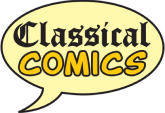In our aim to make the classics relevant, accessible and fun, our beautiful adaptations of classic literature are as close to the original novel or play as we can make them while keeping to the graphic novel format. But how do we do it?
Comic books typically use multiple artists to create the pages of artwork needed. Script Adapters, Pencillers ✏️ Inkers 🖋 Colourists 🖌 and Letterers 🗯 are all required (sometimes one artist can do more than one job) and we choose artists from the comic book world whose style suits the story. This makes each graphic novel that we create unique in artistic style but also faithful to the author’s intentions. For Dracula The Graphic Novel we chose:
Script Adaptation: Jason Cobley
Linework: Staz Johnson
Colours: James Offredi
Letters: Jim Campbell
This sequence shows each of the stages.
1. Script
Dracula The Graphic Novel is produced in two text versions: Original Text and Quick Text. In order to create these two versions of the same book using the same artwork, the story is first adapted into two scripts. (For our Shakespeare titles this is done with three versions). While the text differs for each edition, the artwork remains the same for both books.

2. Character Designs
While the scriptwriting is underway, the artist works on designs for each of the characters, keen to represent them in a way that stayed authentic to Bram Stoker’s book, and not be influenced by the many films that have appeared since. These are some of the initial sketches for Count Dracula.

3. Roughs and Pencils
Once the script is finished, the artist reads the script and lays out the pages. This is arguably the most complex stage. Considerations during this process include the pacing of the story, page count, body language, character sizes, perspective, lettering space, texture and lighting.

4. Inks
When completed, the pencil sketch is then inked. Inking is not simply tracing over the pencil sketch; it is the process of using black ink to fill in the shaded areas and to add clarity and cohesion to the ‘pencils’. On top of that, inking also adds texture and drama, and there is a great example on this page with the burst surrounding Quincey Morris in panel 3.

5. Colours
Adding colour really brings the page to life. There is far more to the colouring stage than just replacing the white areas with colour. Some of the linework itself might be replaced with colour, the light sources are considered for shadows and highlights, and effects added. Finally, the whole page is colour-balanced to the other pages of that scene and to the overall book.

6. Letters
The final stage is to add the captions, sound effects, and speech bubbles from the script, which are laid on top of each coloured page. Two versions of each page are lettered, one for each of the two editions of the book (Original Text and Quick Text).
The lettered pages are then checked, edited and compiled into the finished books, with additional front and back matter added, ready for printing. Below is the finished page 96 with Original Text and Quick Text lettering.



